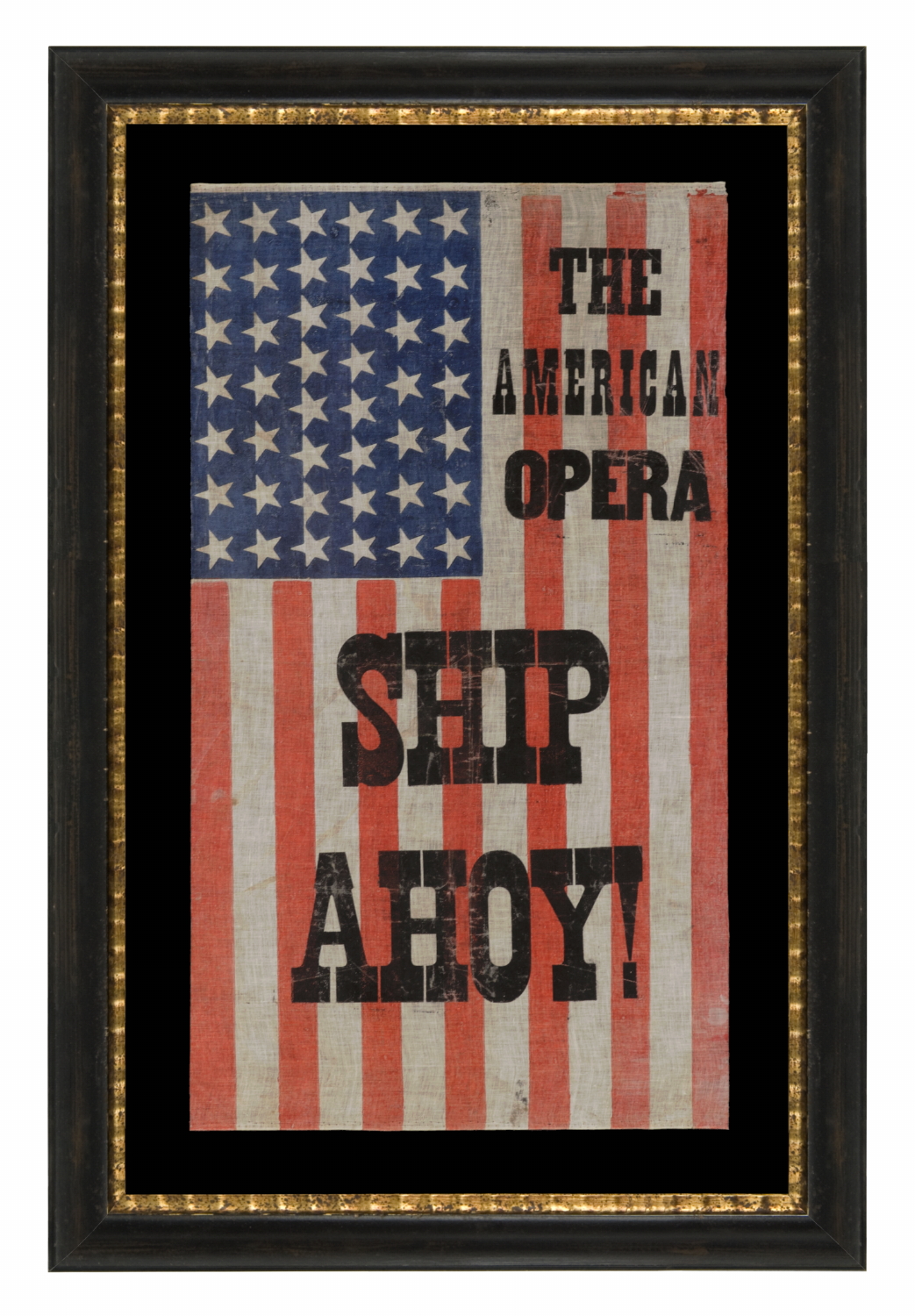


| EXCEPTIONALLY RARE 44 STAR ANTIQUE AMERICAN PARADE FLAG WITH OVERPRINTED ADVERTISING FOR ONE OF ONLY FIVE AMERICAN OPERAS WRITTEN DURING THE 19TH CENTURY: “SHIP AHOY!”; THE ONLY KNOWN EXAMPLE |
|
| Web ID: | 44-004 |
| Available: | In Stock |
| Frame Size (H x L): | 49" x 33.5" |
| Flag Size (H x L): | 36" x 20" |
| Description: | |
| 44 star American national parade flag, printed on coarse, glazed cotton. Overprinted in the stripe field, in gigantic black text, is the following advertisement: The American Opera Ship Ahoy!" Numerous 19th century parade flags survive that feature the names of American presidential candidates, which are highly coveted by collectors. A larger quantity exist that feature verbiage pertaining to the organizations and reunions of Civil War veterans. But surviving flags that feature advertising outside the political and military arenas fall between extremely scarce and extraordinarily rare. Some of these focus on national and public celebrations, such as the 1876 centennial of American independence, while others contain merchant advertising. This is the only flag I have ever encountered that was made to serve as a large broadside/playbill for a theatrical production. Further, across all known examples of overprints that are purely merchant-driven, this flag, by far-and-away, wins first prize for being not only the largest example within that realm, but with the most largest and most dramatic text. Most such flags do not exceed 6 - 10 inches in length, so this is truly a giant among them. Ship Ahoy! was one of only five American operas written during the 19th century and first appeared in New York in the 1890-1891 season. There is mention of it in a book entitled "American Musical Theater: A Chronicle", By Gerald Bordman (Oxford University Press, 1978), on page 120, which sums up the basics: "A more successful novelty ushered in December. Ship Ahoy (8 december 1890, Standard) was billed as an "operatic extravaganza" with a libretto by H. Grattan Donnelly and a score by Fred Miller. A comic-opera troupe is shipwrecked on an island. The men would set up a kingdom with themselves in charge, but the ladies of the ballet, led by Mlle. Auburni Ernani (Bertha Ricci), revolt and establish their own republic. In an ending that ten years later would become a cliché, the troupe is rescued by the U.S. Navy. Because the show was a Philadelphia mounting, New York critics came down hard on it. The Times insisted the dialogue was traditional Philadelphia drivel, while the Dramatic Mirror hear Gilbert and Sullivan in every song. The trade paper cited the song sung by Commodore Columbus Cook (Edward M. Favor) of the U.S.S. Cuckoo as a direct steal from a song it called "The Ruler of the Queen's Navee" ("When I Was a Lad"). The loose plot allowed a flood of vaudeville turns to be inserted, and several critics insisted these were the mainstay of the evening. On a more positive note, Philadelphia productions were usually applauded in New York for the excellence of their sets and costumes, and on this front, Ship Ahoy was no exception. A stage picture of the white squadron sailing out of Chesapeake Bay won general approbation. Willard Spenser and other Philadelphians had long since learned that New York's rejection was rarely repeated on the road. After five weeks the company embarked on a tour that brought it back to several New York theaters. On its return it sought to assure patrons its songs were not cacophonously modern, but were "music with melody."* The 44 star count places it correctly in the period. Wyoming became the 44th state on July 10th, 1890. Many flag makers would have began to add a 44th star to their flags on or before that day, and the 44 star flag would have generally seen use until the addition of Utah in 1896. The flag was formerly sewn to something, perhaps a running banner of some kind, that contained a string of these flags outside a theater. No others like it are presently known to exist, however, so it survives as one-of-a-kind. No others like it are known to exist, however, so it presently survives as one-of-a-kind. Mounting: The flag has been hand-stitched to 100% cotton twill, black in color, which was washed to reduce excess dye. An acid-free agent was added to the wash to further set the dye and the fabric was heat-treated for the same purpose. The mount was then placed in a black-painted, hand-gilded and distressed Italian molding. Condition: There is some pigment loss in the black lettering, but the flag is so powerful in person that it simply overcomes it and so the loss leaves no lasting impression of this fact. There is very minor misprinting of the blue and red pigments and there is very minor foxing and staining. many of my clients prefer early flags to show their age and history of use. * Source: http://books.google.com/books?id=YiBaRas9jTwC&pg=PA120&lpg=PA120&dq=ship+ahoy+opera+1891&source=bl&ots=2Q9-FHkYIj&sig=_ed2oKRXZZgpXCW3EsckHfn8oFo&hl=en&sa=X&ei=lt15UprDC7HdsASwvYC4Cg&ved=0CDQQ6AEwBA#v=onepage&q=ship%20ahoy%20opera%201891&f=false |
|
| Video: | |
| Collector Level: | Flags for the truest Patriots. My best offerings |
| Flag Type: | Parade flag |
| Star Count: | 44 |
| Earliest Date of Origin: | 1890 |
| Latest Date of Origin: | 1891 |
| State/Affiliation: | Pennsylvania |
| War Association: | |
| Price: | Please call (717) 676-0545 or (717) 502-1281 |
| E-mail: | info@jeffbridgman.com |
 |
|